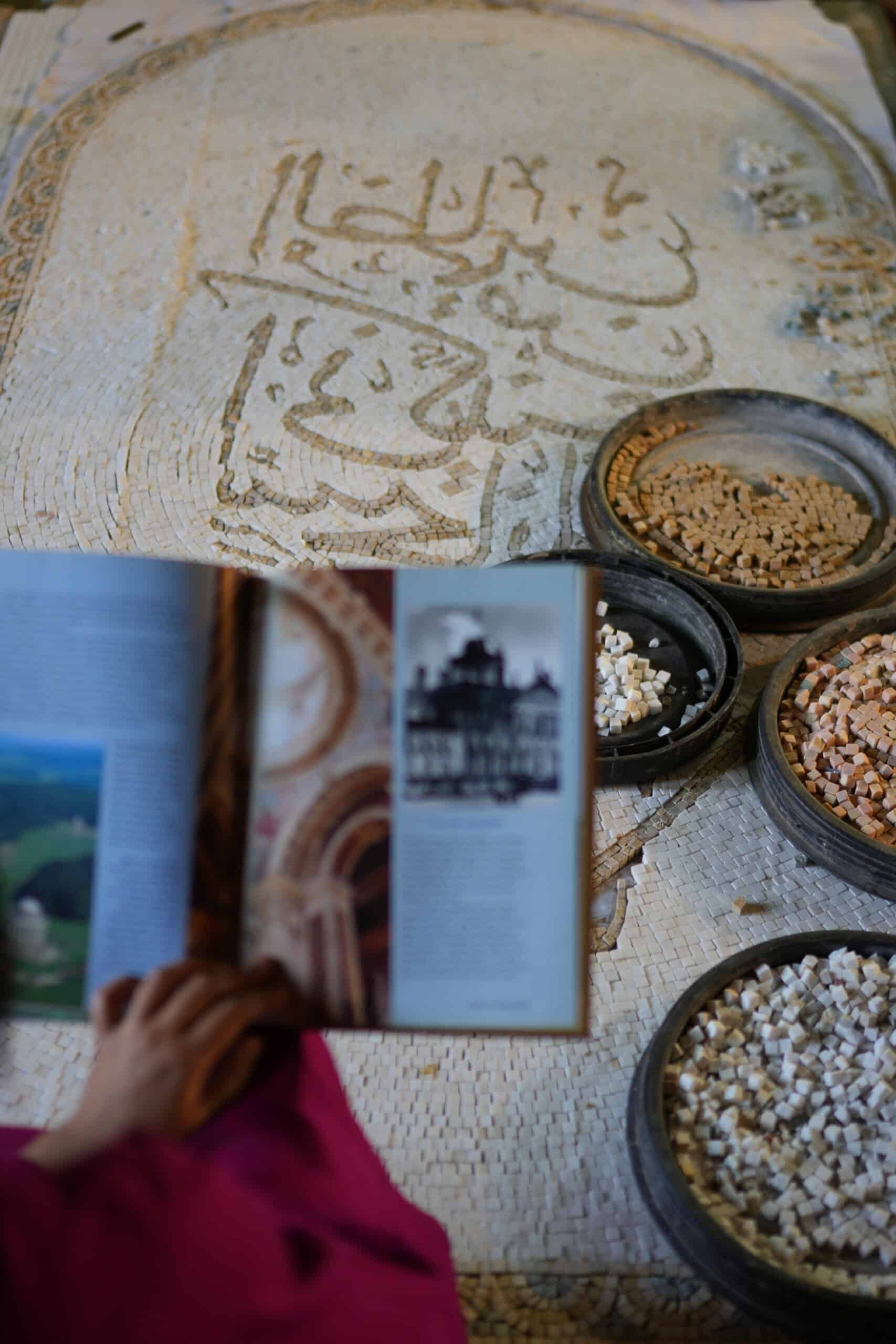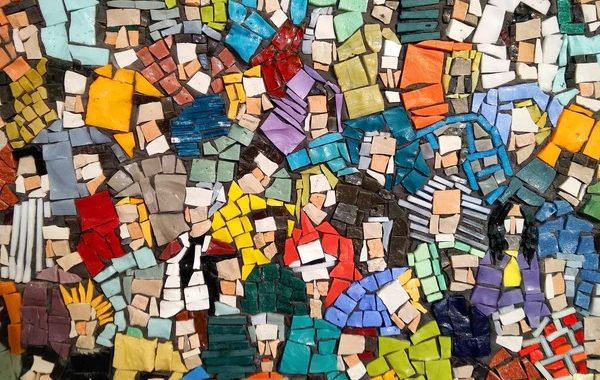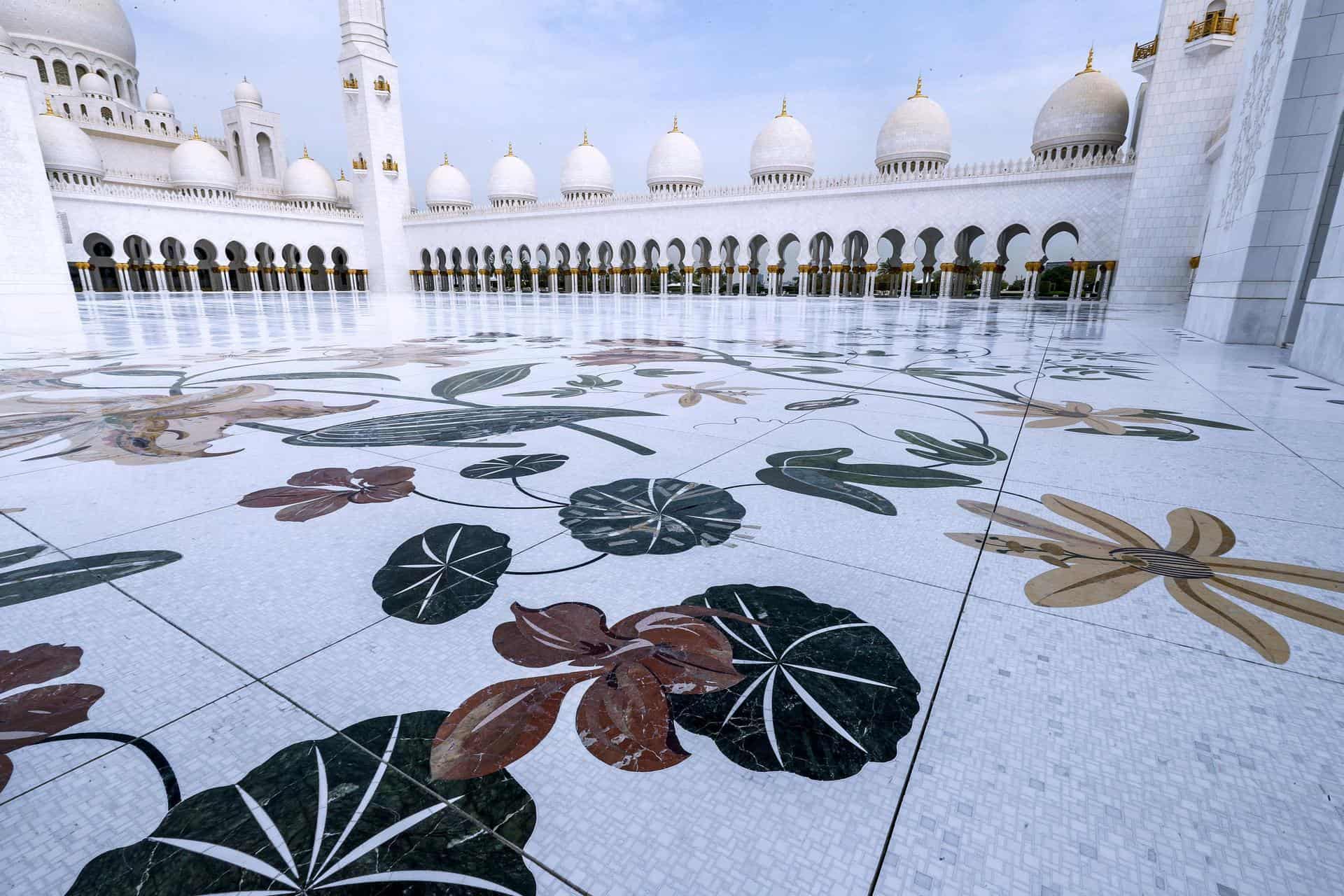Ethnic Mosaic art acts like a cultural bridge between different cultures; it brings people of all backgrounds together via visually spectacular patterns. In its ability to unite people via a shared appreciation of aesthetic beauty, mosaics are a powerful symbol of the infinite variety within the human condition.
The Byzantine Empire is where ethnic mosaic art first appeared, having traveled for a few centuries through Western Europe and the Islamic world. Greek and Roman art and architecture were substantially improved by their Middle Ages transportation throughout Europe.
Table of Contents

History of Ethnic Mosaic Art
Through the 1890s, mosaics saw a revival, aided in part by the Arts and Crafts and other modern art movements. Architects and artists that predicted a more enchanted future often used mosaics. Catalonian Modernist Antoni Gaudí is distinct from other architects in his mosaic technique. His laborious installation of marble, glass, and ceramic mosaic tiles brought the art form to a worldwide audience. Showing the combination of scientific
Various Ethnic Mosaic Art
Mosaic art is an artistic talent that is spread worldwide, if we go back to the very beginning of mosaic art the 4 regions that excelled in mosaic art are mentioned below. MEC also celebrates diverse ethnicities by creating designs related to all of these cultural groups.
Mosaic Art in Romans

The Roman Empire was unmatched in Mosaic art. Though they were not known for inventiveness, the Romans were great photographers. Sometimes, Roman ornamental statues were used as floor decor in public and private areas. Roman mosaics frequently included scenes from hunting and gladiators’ victories.
Generally speaking, the media presented a magnificent and positive image of the Romans. It doesn’t follow that mosaics have the magic formula to fix our issues just because they have been around for a while. Plaster with different stones inlaid was one common Egyptian decorative technique. Still, the Romans did invent a novel method of mosaic production. Little fragments of rainbow stone now cover the panels in place of pebbles. Our mosaicists also feature Roman ethnicity in their mosaic art.
Mosaic Art in Byzantines

Ethnic mosaics were an integral aspect of Byzantine architecture as the empire expanded, and their artists attained levels of creativity, insight, and mastery never before seen. The Christian Byzantine Empire placed a premium on the skilled craftsmanship of ancient Greeks and Romans. During the Byzantine Empire, innovative smart glasses were made using large sheets of multicolored glass.
This effect was achieved by letting light shine through the glass and into the spaces between the small tiles. At the beginning of the sixth century, skilled Byzantine artisans came up with a new way to set glass tiles. They used a mix of heavy-duty resins angled in such a way that more light was reflected. Subjects from the Bible and religion were common in the best Byzantine mosaics.
Mosaic Art in Greeks

Even while mosaics have been present for a while, the oldest ones discovered in Mesopotamia date back to the third millennium BC. The Ancient Greeks emerged in the seventh century BC and, by their painstaking pattern-making and creative design thinking, elevated the art form to a new degree of complexity. Small stones were initially used by the ancient Greeks to carve complex geometric designs. Floor mosaics are made up of most mosaic designs utilized throughout the Greco-Roman era.
The reason these huge designs were selected was that should a structure collapse, they would sustain less harm. It helps explain their endurance and appeal as many of them are still standing today. Greek mosaics elevated the medium and provided the foundation for a multitude of methods. Hellenistic temples and residences often had it installed as flooring. Some of the Greek mosaic designs have been made by our mosaicists. Each mosaic tile has been cut and carefully chosen to make Greek mosaic designs, which is also the practice that MEC adopted.
Mosaic Art in the Islamic world


While Muslims conquered the Eastern domains of the Byzantine Empire, they also adopted ethnic Byzantine architectural techniques. In Islamic architecture of Asia and North Africa, mosaic techniques were used to decorate palaces and holy buildings. When compared to European mosaicists, Islamic artists and craftspeople took a radically different tack with their work. Previously employed to produce larger, recognizable figures, clay, and small glass were now utilized to create elaborate patterns.
Islamic mosaics are tessellations, or periodic tiling with geometric motifs and repeating patterns without overlapping areas. The geometric mosaic patterns’ precision and complexity stunned mathematicians. After the seventh century, the Islamic world momentarily lost interest in mosaic art. Our mosaicist also designed some Islamic mosaic art, like designing Islamic calligraphy with mosaic tiles for mosques and mosaic art on domes of mosques.
The culture and tradition of the Muslim countries are also represented with mosaic art, the whirling dervish is a famous piece of art that holds a name when it comes to representing Islamic countries through mosaic art
The Role of Mosaic Art in celebrating diversity in ethnicities

Image source: worldartcommunity
Mosaic patterns are particularly beautiful as they can transcend borders and influence art from various ethnicities. The cultural bridge that mosaic art forms is a way to let ideas and techniques of creativity go from East to West. Beautiful mosaics that showed the interconnectedness of the human experience were the result of this cross-cultural fertilization combining the creative traditions of various countries.
Symbolism and Representation of Cultural Heritage
Mosaic designs have more elements than just a decorative piece. They are examples of cultural identity, innovation, and historical continuity. For years, mosaic patterns have adorned the monuments, artworks, and buildings of many civilizations. Their aesthetics, values, and ideas are mirrored in them by both their creators and consumers. The cultural significance of mosaic patterns will be examined from many perspectives in this portion.
Universal Language of Creativity and Beauty
Mosaic art fosters a feeling of unity and common identity by often including community cooperation. Mosaic pattern public art projects in the modern setting inspire people to unite, tell tales, and express their shared identity.
Celebrating Diversity With Ethnic Mosaics



Often, schools, artists, and community members work together on mosaic graffiti projects. Many different points of view, experiences, and artistic contributions are brought to these initiatives by the participation of a broad range of people. These alliances provide a feeling of success and shared ownership that honors the diversity of the community and strengthens relationships.
The mosaic mural project “Unity in Diversity” located in a multicultural neighborhood is a prime example of this kind of collaboration. Locals created an outstanding work of art that embodies the rich cultural traditions and legacy of the area in collaboration with children from nearby schools and professional mosaic artists. Every mosaic tile represents a distinct ethnic feature of the neighborhood that captures its general essence.
Fostering knowledge and connection among diverse communities
The growth of studies in cultural heritage proves that socio-economic, socio-political, policy, and cultural management activities are the primary instruments of the trade for heritage preservation, conservation, development, and sustainability.
In addition, studies in Cultural Heritage Studies are associated with positivistic and pragmatic academic traditions, which involve priorities for the performative, functional, and applicational aspects of various theoretical notions. More than that, heritage(es) are embraced in the sense that they are declared by various communities or cultural groupings.
Thus, from the point of view of this research, it proves impossible to explain the model of heritage of mosaic creation activities by the two widely used techniques of cultural heritage management and policy.
Promoting acceptance and celebration of ethnic differences
Community mosaic art is an expression of diversity, an encouragement to be kind to each other, and an invitation to celebrate our differences.
Symbolism of Diversity
By nature, mosaic art is made up of many different things; many different materials, colors, and patterns. Such diversity intrinsically celebrates diversities in ethnicities. People from various ethnicities and experiences can come together and form a peaceful society—just as different individual tiles come together to form a solid mosaic. This symbolism reminds us that no matter how hard it may seem to reconcile diversity, it is beautiful and necessary for the building of robust, sturdy societies.
Inclusive Participation
Mosaic art activities bring together people of all ages, abilities, and backgrounds, encouraging a sense of ownership and belonging to the project. This ensures the improvement of the project as different skills of an individual and views are pooled as inputs.
Visibilities and Representation

Mosaic art may be used to commemorate as well as represent various identities and experiences in a community. The artists may use different symbols, imagery, and narratives in an attempt to explain the cultural, ethnic, and social diversities within a group. Mosaic art also shows invisible ethnicities and makes them visible by putting all the people presented and making other people’s opinions known.
Community Ownership and Empowerment
Community art projects, such as mosaic works, assure community members that they own their part of the spaces as well as their own stories. From the process of joint design and production, the community members are empowered to take ownership of their surroundings and are attached to their environment. The empowerment of community members ensures that they accept differences and actively participate in promoting a more inclusive and accepting community culture.
Modern-era Ethnic Mosaics

Mosaics are still a common decorative method and an artistic medium in modern art. Artists are reinterpreting the techniques first used by the ancient Greeks elsewhere in the globe. While some artisans continued to work with these traditional methods, others began experimenting with new ways to create beautiful mosaics. A major innovation was the grid system.
With time, mosaic artists refined their skills. Grindstones, rollers, brushes, and stamps were just a few of the new techniques and tools they invented. These advances allowed them to create ever more complex works of art. These days, mosaic flooring is still very popular in homes since it is durable, reasonably priced, and flexible.
Examples of notable architectural projects incorporating Ethnic Mosaic Art
Mosaic has been used since ancient times in architecture and has been a potent form of storytelling with visuals for structures all around the world, giving them grandeur and richness. Selected examples of this art form from countries all over the world in different periods of history demonstrate the adaptability and classic beauty of mosaic work. Let’s have a closer look at these truly exceptional cases.
1) St George’s Church, Topola, Serbia
Some of the world’s best and richest specimens of Byzantine art can be found in the Ethnic mosaics of St. George’s Church. These historical and religious subjects are accompanied by great representations of famous people and rulers of that period.
Mosaics are made up of countless tiny pieces of colored marble, stone, and glass, that have been put together exactly to form a single large image. Larger panels depict narratives from the Old and New Testaments, such as the Crucifixion, as well as the birth of Jesus. The Church of St. George mosaics are, relatively speaking, in very good condition.
2) Magic Gardens Philadelphia, Pennsylvania, USA
There is a huge open-air installation of sculptures in mosaics covering the bridges crossing over each other in the center of Philadelphia itself: Magic Gardens.
Master artist of Ethnic mosaic, Isaiah Zagar spent more than a decade in the construction of this site using recycled and salvaged materials in making the gardens. Most conspicuous are the mosaic walls comprising hundreds of pieces of colored glass, tiles, and mirrors.
There is not a single element shared between the different pieces in this complex and sophisticated work of art. Along with these are various sculptures, from abstract forms to more representational pieces.
3) Sheikh Zayed Grand Mosque, Abu Dhabi, UAE

Image source: arcpublishing.com
Pretty much, the Sheikh Zayed Grand Mosque is known for its beautiful mosaics. This is because, not only are the interiors pretty in themselves, but the mosque is one of the most beautiful Islamic structures in the world because of the intricate work that adorns its walls, columns, and domes.
Quranic verse fragments are littered between the stunning geometric and floral-inspired designs on the tiles. They are made from a variety of colored and textured semi-precious stones, marble, and glass.
Mosaics cover more than 7,000 square meters at the mosque, and Hussain Ali, an Emirati artist, designed them. It took him more than four years to complete it. Building design that incorporates mosaic craftsmanship conveys a significant effect on stylish offer and social representation.
Conclusion
Ethnic mosaic art is no doubt a connecting bridge between various cultures, hence mosaic art is not only confined to the East or the West rather it connects both worlds through its beauty. Various monuments of the world are excellent examples of mosaic art diversity, like Sheikh Zayed mosque in the United Arab Emirates, St George’s church in Serbia, and many more. It is only fair to say that mosaic art brings people from various parts of the world together and celebrates diversity with its contrasting colors and designs. People from all over the world come together and show their talent with their unique mosaic designs.
What is a mosaic in art and design?
In mosaic art, a surface is decorated with tiny, variably colored bits of material known as tesserae. Though numerous materials can be used to make tesserae, stone, glass, and ceramic are the most regularly utilized ones. Painting and mosaic art both produce pictorial artwork on a two-dimensional surface in a relatively comparable way.
How does art contribute to a culture of diversity?
Art and design took together to dramatically expand variety and inclusiveness. Art and design may help to dismantle and challenge prejudices, provide voiceless individuals a forum, and encourage empathy and understanding among different cultures by imaginatively portraying multiple points of view
What is the importance of mosaic art?
In mosaic art, durability, and sustainability coexist with ageless beauty and exquisite workmanship. With those elements and many more, it is among the most significant artistic manifestations in human history.
What is a mosaic in cultural and creative art?
Mosaic art is the decorative use of small, colorful material fragments on a surface. Stone, glass, tile, and a host of other materials can be used to build the components or tesserae. Glue holds them to the surface.
